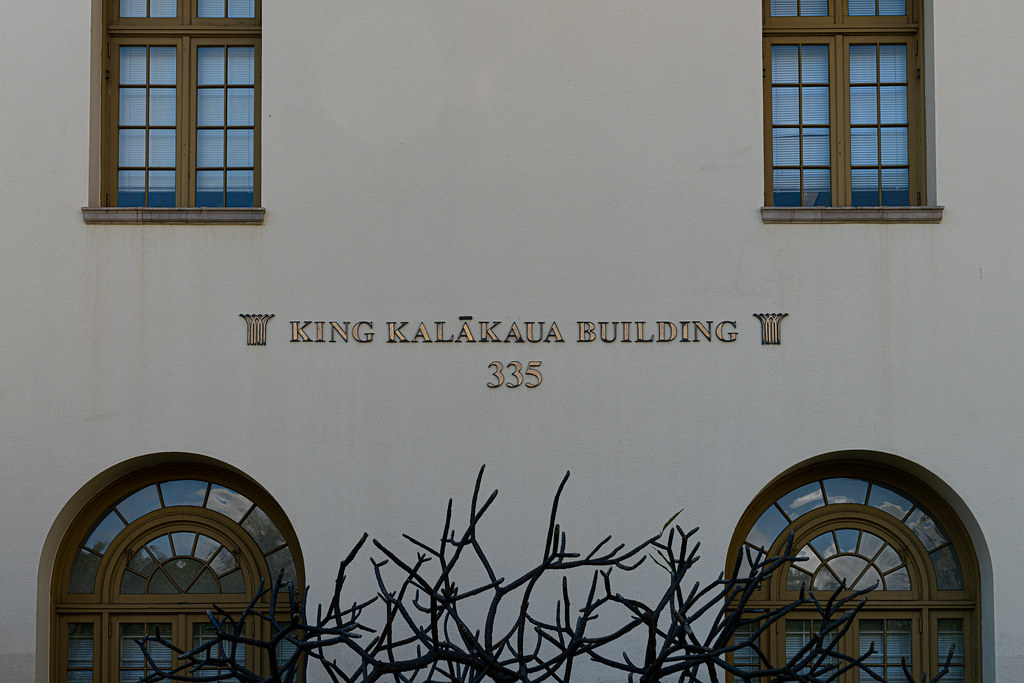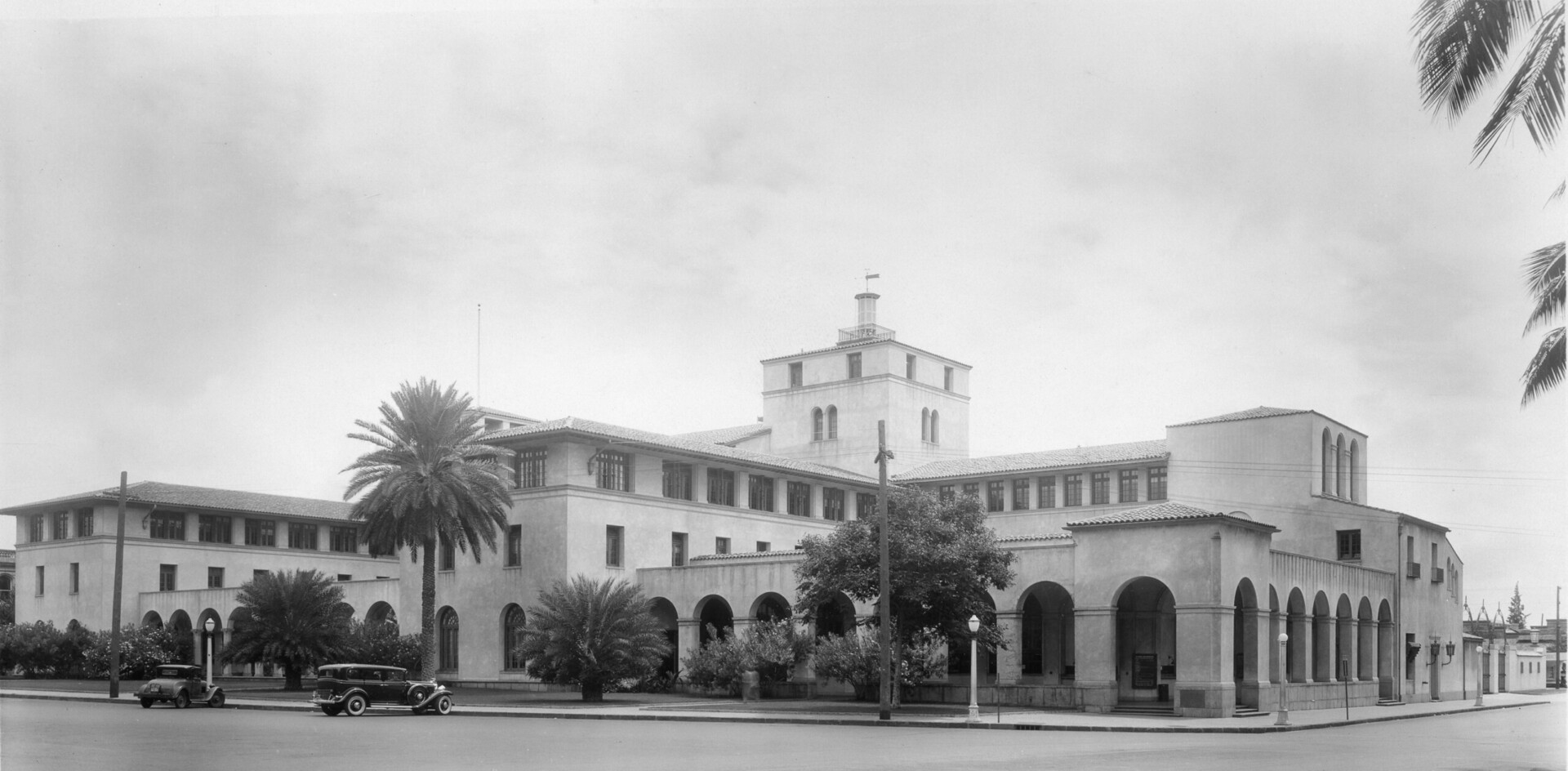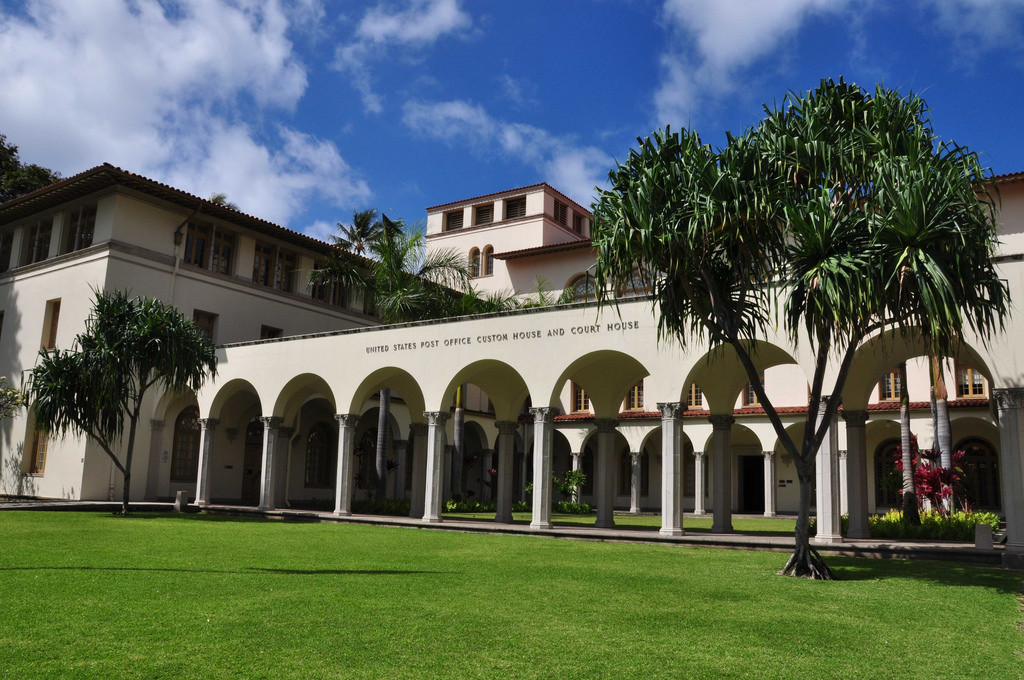The History & Architecture
The King David Kalākaua Building in Honolulu is a government building at 335 Merchant Street originally built for the U.S. Post Office, Customhouse, and Courthouse. It served as the official seat of administration for the Territory of Hawaii.
The building sits opposite Iolani Palace on the previous site of the opera house. It was designed in 1918 by New York architecture firm York and Sawyer in cooperation with local architects, and built from 1921 to 1922 in the Mission/Spanish Revival style. An addition to the building for the Treasury Department was started in 1929 and opened in 1931.

Design features include terracotta tile, adobe and stucco walls, courtyards, arches, arcades, towers, and bell-gables. Hawai‘i-based architects included a melding of outdoor-indoor spaces, skylights, local decorative elements, and adaptations to accommodate trade winds and maximize air flow.
Some of its significant architectural features include its asymmetrical composition and cluster design, with structures joined by the exterior arcade and corridors. A flat-roofed arcade wraps from Merchant to Richards Streets around the mauka side of the building and leads into a corridor lined with postboxes—creating a seamless transition between the outside and inside. Neoclassical columns with stylized hibiscus blossoms give a nod to Hawai‘i. Inside, a spacious lobby with a marble double staircase establishes a sense of openness, which is matched by the wide main corridors on the second and third floors. The building is set back from the street behind a lawn with tropical trees and foliage.
Although its stucco and terracotta style contrasts with the more ornate Neoclassical styles of its neighbors Iolani Palace and Ali‘iōlani Hale, its Spanish Colonial Revival vernacular links it with the nearby Honolulu Hale complex.
Its current use is to house the offices of the State Department of Commerce & Consumer Affairs and the Downtown Post Office.
 A chronology of significant events for the U.S. Post Office, Court House and Custom House/King David Kalākaua Building:
A chronology of significant events for the U.S. Post Office, Court House and Custom House/King David Kalākaua Building:

Image: U.S. Post Office, Court House, and Custom House (1931 photo) National Archives – National Archives, RG 121-BS, Box 20, Folder E, Print 16652. Public Domain.
- 1892: Overthrow of Hawaiian monarchy; 1893 Lili‘uokalani deposed—President Benjamin Harrison dispatched sailors from the USS Boston to surround the royal palace.
- 1894: Dole sent a delegation to Washington to seek annexation, but the new president, Grover Cleveland, opposed annexation and tried to restore the queen.
- 1898: spurred by nationalism aroused by the Spanish-American War and concerned that Hawai‘i would become part of a European empire, the US annexed Hawai‘i under President William McKinley.
- 1900: made a territory in 1900. Dole became its first governor.
- 1922: Built as the seat of Territorial government. Chose this site opposite the Palace; originally an opera house stood here. Known as the “Federal Building”.
- 1959: Statehood.
- In 1975, the building was listed to the National Register of Historic Places under the former name.
- In 1977, the federal court & custom house moved to the new Prince Kūhiō Federal Office Building; only the post office stayed.
- In 1978, the building was included as a contributing property in the NRHP listing of the Hawai‘i Capital Historic District.
- Late 1990s: The federal government developed a plan to sell the empty parts of the building to a developer who planned a shopping center, restaurant and wedding chapel, with a skyscraper plugged into the central courtyard, but the deal fell through in 2000.
- In 2002, the state reached a deal for Par Development LLC, an affiliate of Denver-based RSD Corp., to buy the building from the U.S. Postal Service for $7 million, restore it, bring the interior up to standards and then sell 120,000 square feet of the 160,000-square-foot property to the state for $32.5 million. The Postal Service bought back the rest of the improved space for $1.
- Also in 2002, it was renamed as King David Kalākaua Building by the state. The renaming of the building and the purchase and occupation of it by the state from the federal government was symbolic. King David Kalākaua (reigned 1874-1891) served as postmaster from 1863-65. His resurrection of Hawaiian culture helped fuel political opposition that eventually bought down the Hawaiian monarchy in 1892.
- December 29, 2003 – Traditional Hawaiian ceremonies were held in the courtyard to mark the state’s move into this former federal
Sources
Associated Press, “Historic Building Gets New Life”. Star Bulletin, December 30, 2003.
Burlingame, Burl, “Holoholo Honolulu, A Walking Tour”. Star Bulletin, July 11, 2004.
Hibbard, Don J., Buildings of Hawai‘i. University of Virginia Press, 2011.
Sandler, Rob, Architecture in Hawai‘i: A Chronological Survey. Mutual Publishing, 1993.
Further Resources
Click here to view the United States Post Office, Custom House & Court House National Register of Historic Places nomination.
Click here to view the Hawai’i Capital Historic District National Register of Historic Places nomination.
Tour the Historic Buildings and Public Art of the Hawai’i Capital Historic District. Click here to take the Story Map Tour.


